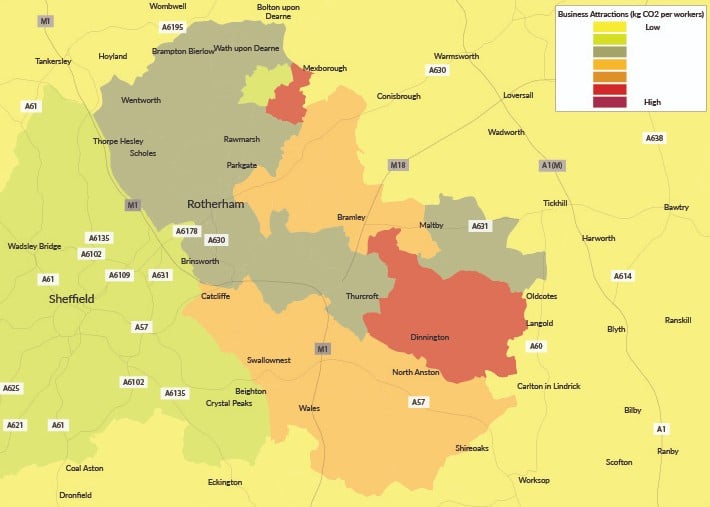Supporting a sustainable Transport vision
Improving the quality of life for people is a core element of Rotherham Metropolitan Borough Council’s (RMBC) transport vision, with transport supporting quality of life by providing access to opportunities and by promoting health by enabling sustainable and active travel choices.
To help build a sustainable transport strategy, RMBC needed to gain a greater understanding of the baseline transport related CO2 emissions for the Borough. This included breaking down the emissions by the main transport modes as well as by travel within, to and from Rotherham, and also identifying emissions generated by pass-through traffic.
This baseline would enable RMBC to build an understanding of the impact of transport on their Carbon budget and was a required component of the initial development of a strategy to meet their ambitions to become net-zero by 2040.

CO2 Emissions insight
In late 2021, RMBC appointed SYSTRA to undertake some initial work to provide modelling support to feed into their understanding of CO2 emissions. This exploratory work included developing an innovative Carbon Skimming approach which generated Production-Attraction (PA) matrices of CO2 from a highway assignment and link-based emissions calculated using SYSTRA’s Emissions Evaluation Tool(ENEVAL). This approach allowed a new set of powerful analyses of CO2 emissions to be undertaken which had not previously been considered.
This initial development phase provided confidence that the approach produced results which were comparable to estimates of CO2 from other published sources. Building on this initial proof of concept, RMBC commissioned SYSTRA to undertake additional work to further enhance their understanding of CO2 emissions. These additional analyses included:
- Production of CO2 emissions at ward level to establish which wards within the RMBC area contributed the most emissions.
- Expansion of the Carbon Skimming approach to illustrate CO2 intensity through metrics such as CO2 produced per capita by ward (see below) and commute (attraction) based CO2 per worker.
- Production of CO2 length distribution by presenting the emissions by distance band and comparing it with a traditional trip length distribution. This analysis illustrated the trip lengths that contributed the most CO2 emissions and where efforts should be targeted to reduce emissions. In particular it became clear that the bands with highest numbers of trips were not necessarily responsible for the most emissions.
- Estimates were made for emissions that were not included in the strategic model, such as short trips that are undertaken wholly within a model zone, the first and last mile of trips (usually not fully represented in a model of this nature), and by non-modelled modes (eg motorcycle). These estimates were used to apply an adjustment to the CO2 estimates produced in this study
- A benchmarking exercise against CO2 data published by the Department for Business, Energy and Industrial Strategy (BEIS) and Centre for Research into Energy Demand Solutions (CREDS) data to demonstrate alignment with the RMBC Local Authority published figures.
A Baseline for ONgoing Strategy Development
The SYSTRA analysis was incorporated in to RMBC’s Transport Strategy summary findings report, and will serve as a baseline to ongoing transport strategy development.
SYSTRA’s processes made it possible to evaluate emissions released only in the RMBC Local Authority area, while still understanding the full OD of the trips that produced those emissions. This proved valuable for Local Authority understanding of carbon emissions, enabling the strategy to focus on the highest carbon generation transport movements for their Net Zero strategy.
The ground-breaking work undertaken for RMBC proved the ability to undertake analysis of CO2 using the new and innovative processes. The tools and application developed for this study are fully repeatable in any location which has a highway assignment model, and we are considering a solution which would allow this to be done even where an assignment model is not available. The analyses can also be extended to include other emission types.
 Australia
Australia  Brazil
Brazil  Canada
Canada  China
China  Denmark
Denmark  France
France  India
India  Indonesia
Indonesia  Ireland
Ireland  Italy
Italy  Malaysia
Malaysia  New Zealand
New Zealand  Norway
Norway  Poland
Poland  Saudi Arabia
Saudi Arabia  Singapore
Singapore  South Korea
South Korea  Sweden
Sweden  Taiwan
Taiwan  Thailand
Thailand  United States
United States  Vietnam
Vietnam